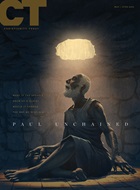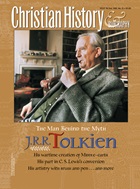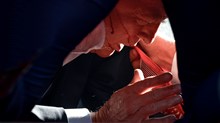The sudden boom in the popularity of The Lord of the Rings in the mid-1960s began with the simple fact that it became available in paperback.
An unauthorized American edition arising from a seeming loophole in the book's copyright stirred Tolkien's publishers like a sleeping dragon roused.
In October 1965, Ballantine published an approved and slightly revised three-volume edition at 95 cents each. Now anyone with three dollars could buy a passport to Middle-earth.
By 1966, the book was the top-selling paperback, with three quarters of a million copies in print.
Happy accident?
Tolkien scholar Douglas A. Anderson (author of The Annotated Hobbit) believes it was "an accident of chronology" that The Lord of the Rings found a wide audience thirty years after Tolkien began writing it and ten years after its first publication.
"Part of it has to do with the rise of mass market publishing, and the fact that a mass market edition came out in 1965 surely spurred things along. Before then, the hardcovers were at least $5 each volume. Of course, the fact that the establishment didn't look kindly on Tolkien probably only fueled the fact that the younger generation did."
Tom Shippey adds other reasons:
"Perhaps one could say he offered a 'mellow' kind of heroism, which he was convinced was also old, familiar, and natural. And also, the students of the 1960s were perfectly well able to see that through the metaphor, Tolkien was writing about real life: the connection to Vietnam and the military-industrial complex (Mordor and Saruman) was obvious—though not intended."
Rightly or wrongly, contemporary accounts of the sales surge handcuffed it to the collegiate counter-culture. In "The Hobbit Habit," published July 15, 1966, Time magazine proclaimed that Tolkien was the new literary BMOC (Big Man On Campus):
"Holden Caulfield is a moldy fig; the Lord of the Flies is swatted. This year, the unquestioned literary god on college campuses is a three-foot-high creature with long curly hair on his feet, a passion for six vast meals a day, and the improbable name of Frodo Baggins."
A tract for its time
The Time article noted the proliferation of buttons declaring FRODO LIVES and GO GO GANDALF on many U.S. campuses and declared, "The hobbit habit seems almost as catching as LSD." Three reasons for this vogue were suggested:
"To some, it is a poetic portrayal of the times, with Sauron and his destructive force seen as an analogy to atomic war. For others, the Frodo saga represents a way to escape the mundane realities of life. … Another enthusiast likes the Rings' old-fashioned moral simplicity: 'You cheer the hero and boo the villain.'"
The backlash against the so-called Tolkien cult came swiftly, and it was based not so much on the book itself as on its readers: an ad hominem attack. On February 24, 1967, Life associate editor Charles Elliott declared:
"Tolkien is obscure no longer. He has become, in fact, the literary darling of an entire generation of high school and college students, who have made him a flagrant best-seller—smack at the top of the 1966 paperback list." Elliott accused "the opt-out crowd" of liking The Lord of the Rings because it was "innocent of ideas." He concluded, "These days the student must find solace where he can, if necessary in the Baggins of Bag End bag."
The painfully dated slang aside, Elliott's article reveals one problem Tolkien's advocates faced in those early years: literary snobbishness. Edmund Wilson's scathing 1956 Nation article "Oo, Those Awful Orcs!" is another notorious example. Wilson dismissed the trilogy as "balderdash" and "juvenile trash."
Those charming lads
Perhaps the Tolkien boom was part of an American Anglophilia then triumphant in film, music, and literature. Ian Fleming's James Bond spy novels were spawning several superlatively successful Sean Connery films, peaking with the top-grossing Goldfinger in 1964 and Thunderball a year later.
And the hobbits weren't the only four charming, cheeky English lads to win American hearts. On February 9, 1964, the curtains parted on Ed Sullivan's stage and the Beatles entered American popular history as an estimated 73 million viewers watched. Other English bands would invade hot on the Beatles' boot-heels.
As Phillip Norman first revealed in his Beatle history Shout!, in 1968 the two foursomes nearly fused when the Beatles planned producing a film version of The Lord of the Rings starring themselves. That idea was aborted when the chosen director, Stanley Kubrick, convinced John Lennon and Paul McCartney that a Tolkien film was "unmakeable," according to Denis O'Dell's fascinating account in At The Apple's Core.
Seen thus, Tolkien's popularity was a third manifestation of pop-cultural Anglophilia. Other factors, from political paranoia to "pipeweed," have also been credited with spurring the trilogy's success.
The real reason
But Tolkien's popularity wasn't only counter-cultural. When the Time article above was first published, precocious grade-school readers were discovering the book. Professor Clyde Kilby of Wheaton College (Illinois), hardly a hippie, was in Oxford working with Tolkien on what would become The Silmarillion.
By the end of the decade, scholars and fans were joining to form groups like the Tolkien Society of America, The Tolkien Society, and the Mythopoeic Society.
The Tolkien boom had begun. There has been no bust: combined sales for the four Ballantine editions and Houghton Mifflin trade paperback editions comprising The Hobbit and The Lord of the Rings totaled 10.5 million copies in 2001, according to Publishers Weekly. The Peter Jackson films brought many readers to Tolkien for the first time and many erstwhile readers back for another look.
Perhaps the reason The Lord of the Rings has been popular with so many of such different backgrounds is as simple as this: it is, first and last, a great story. Its themes—friendship, choice, power, nature, machines, loss, salvation—are not of one time, but for all time. As Bilbo once sang, "The Road goes ever on."
Michael Foster is a professor of English at Illinois Central College and, since 1995, North American representative of The Tolkien Society.
The "idol" speaks
Tolkien had mixed reactions to his newfound fame.Writing to his colleague Norman Davis, he referred to the widespread enthusiasm for his books as "my deplorable cultus"; and to a reporter who asked him if he was pleased by the enthusiasm of the young Americans he replied: "Art moves them and they don't know what they've been moved by and they get quite drunk on it. Many young Americans are involved in the stories in a way that I'm not." … Americans who were enthusiastic about his books began to make pilgrimages to see him. … Early in 1968 the BBC made a film about him, which they called "Tolkien in Oxford"; he performed unselfconsciously to the camera, and enjoyed himself in a mild way. Yet on the whole this kind of thing did not please him. He wrote to a reader: "Being a cult figure in one's own lifetime I am afraid is not at all pleasant. However I do not find that it tends to puff one up; in my case at any rate it makes me feel extremely small and inadequate. But even the nose of a very modest idol cannot remain entirely untickled by the sweet smell of incense."
—Humphrey Carpenter, Tolkien: A Biography (Houghton Mifflin, 1977).
Perhaps rather naturally, he had mixed and somewhat antithetical feelings about any public image of himself. On the one hand, he was proud of seeing himself as a successful writer. I had the impression that some of his colleagues at the university (and possibly also some of his own relatives) had lifted eyebrows concerning his decades of toil over Elves and Orcs and dragons. Now all but the most cynical were put in their places and even the cynical could not fail to admit that the work, whether good or bad, had paid off financially. On the other hand, Tolkien took appreciations with a grain of salt. Like Lewis, he held a low opinion of the twentieth century, literary critics and all.
Reporters, he assured me, always got things wrong. Actually Tolkien was not the sort of person, if indeed anyone is, who could be captured in the oversimplification of the feature article. This was especially true of articles which emphasized him as a cult-figure and something more or less than human. This attitude may have been why Tolkien managed so remarkably to keep the events of his actual life hidden from the public. Of some of the features published about him, he remarked that too many people thought him 'a gargoyle to be gaped at.'"
—Clyde Kilby, Tolkien and The Silmarillion (Harold Shaw, 1976).
Permission to quote from Tolkien and the Silmarillion, by Clyde S. Kilby, granted by The Marion E. Wade Center, Wheaton College, Wheaton, Illinois.
Copyright © 2003 by the author or Christianity Today/Christian History magazine.
Click here for reprint information on Christian History.

Support Our Work
Subscribe to CT for less than $4.25/month





























